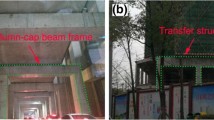Abstract
Six full-scale steel-concrete composite substructures with full and partial shear connection representing half bay within a moment-resisting frame were built and tested both in a, quasi-static cyclic and pseudo-dynamic regime. The specimens embodied two composite beams with full shear connection and four companion beams with two different degrees of partial shear connection all with exterior rigid joints.
Tests were conducted in a set-up purposely designed to impose to specimens reversed horizontal displacements in a low-cycle high amplitude regime. The characteristics of the test apparatus ready for different structural members subjected to horizontal loading are illustrated. Moreover, the seismic performances of the specimens in terms of yielding and of maximum strength capacity as well as of displacement ductility are assessed. Finally, the accuracy of a European code calibrated upon monotonic loading is provided and other local characteristics of the composite substructure behaviour with low partial shear connection are commented upon.
Résumé
Six poutres mixtes béton-acier à échelle réelle ayant des connections au cisaillement complètes et partielles, représentant une démi-travée, dans le cadre d’une structure qui résiste aux moments, ont été construites et testées aussi bien dans un régime cyclique quasi-statique que dans un régime pseudo-dynamique. Les spécimens sont constitués de deux poutres composites ayant des connections au cisaillement, complètes et quatre poutres, de même dimension ayant deux différents degrés de connections au cisaillement partielles, toutes ayant des jointures extérieures et rigides.
Les essais ont été faits selon une configuration étudiée intentionnellement pour imposer aux spécimens des déplacements horizontaux et opposés dans un régime à bas cycle et à haute amplitude. On expose les caractéristiques de l’appareillage destiné aux essais des différents membres structuraux soumis aux charges horizontales. En outre, les performances sismiques des spécimens ont été évaluées aussi bien du point de vue de l’éervement, et de la capacité maximale de résistance que de la ductilité du déplacement. Enfin, une comparaison d’un code européen calibré sur une charge monotone est vérifiée et d’autres caractéristiques locales de la conduite de la substructure mixte ayant un degré bas des connections au cisaillement, sont commentées.
Similar content being viewed by others
References
European Committee for Standardisation, ‘Eurocode 8-ENV 1998-1-3. Design provisions for earthquake resistance of structures-Part 1–3: Specific rules for various materials and elements’ (1994).
Kindmann, R. and Meinsma, C., ‘Steel-concrete composite structures under earthquake loading in Dynamics of Civil Eng. Structures’, Kratzig and Niemann Ed., Balkema, Rotterdam, (1996) 201–220.
Bursi, O. S. and Gramola, G., ‘Behaviour of headed stud shear connectors under low-cycle high amplitude displacement’,Mater. Struct. 32 (1999) 290–297.
Meinsma, C., ‘On the earthquake resistant design of steel-concrete composite frames’, in ‘EURODYN ‘96’, Proc. of Third European Conf. on Structural Dynamics’, Florence, June, 1 (1996) 185–192.
Arbed-Recherches, ‘Seismic resistance of composite structures’, Project Final Report, C.E.C. Agreement No. 7210-SA/506 (1990).
Bouwkamp, J. G., Parung, H. and Plumier, A., ‘Bi-directional cyclic response study of 3-D composite frame’, in ‘Eleventh European Conf. on Earthquake Engineering’ Proc. Europ. Conf., Paris, September, (1998).
Bursi, O. S. and Ballerini, M., ‘Low-cycle behaviour and analysis of steel-concrete composite substructures’, in ‘Composite Construction—Conventional and Innovative’, Proc. Int. Conf. Innsbruck, Sept. (1997) 615–620.
Bursi, O. S. and Gramola, G. ‘Seismic performance of composite substructure with full and partial shear connection’. in ‘Structural Stability Research Council’ Proc. Toronto June, (1997) 13–24.
European Committee for Standardisation, ‘Eurocode 4—ENV 1994-1-1. Design of composite steel and concrete structures-Part 1-1: General rules and rules for buildings’ (1992).
Bursi, O. S. and Zandonini, R. ‘A numerical validation study for pseudodynamic analysis of semi-rigid composite sway frames’, in ‘Structural Stability and Design’, Proc. Int. Conf. Sydney, Oct. (1995) 237–242.
Technical Committee 13, ‘Recommended testing procedures for assessing the behaviour of structural steel elements under cyclic loads’, European Convention for Constructional Steelwork, 45 (1986)
Earthquake Engineering Research Institute, ‘Theme issue: Experimental methods.’,Earthquake Spectra.12 (1) (1996).
Shing, P. B., Vannan, M. T. and Carter, E., ‘Implicit time integration for pseudodynamic tests’,Earthquake Engineering and Structural Dynamics.20 (1991), 551–576.
Bursi, O. S., Shing, P. B. and Radakovic-Guzina, Z., ‘Pseudodynamic testing of strain-softening systems with adaptive time steps’,Ibid..23 (1994) 745–760.
Takanashi, K. and Udagawa, K., ‘Behaviors of steel and composite beams at various displacement rates’,J. of Structural Eng. 115 (8) (1989) 2067–2081.
Building Seismic Safety Council ‘NEHRP recommended provisions for seismic regulations for new buildings and other structures’, Washington D.C. (1997).
Author information
Authors and Affiliations
Rights and permissions
About this article
Cite this article
Bursi, O.S., Gramola, G. Behaviour of composite substructures with full and partial shear connection under quasi-static cyclic and pseudo-dynamic displacements. Mat. Struct. 33, 154–163 (2000). https://doi.org/10.1007/BF02479409
Received:
Accepted:
Issue Date:
DOI: https://doi.org/10.1007/BF02479409




